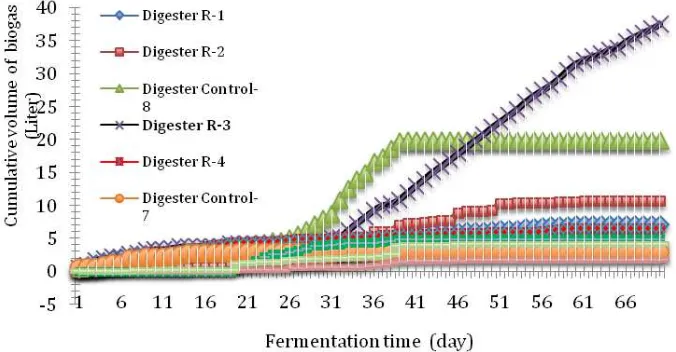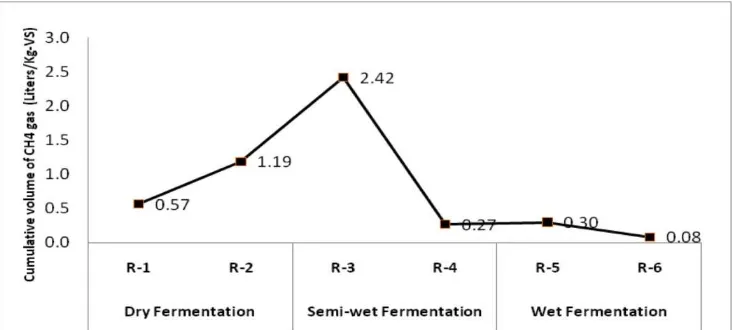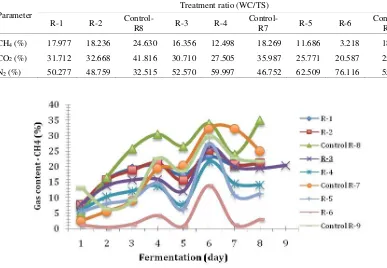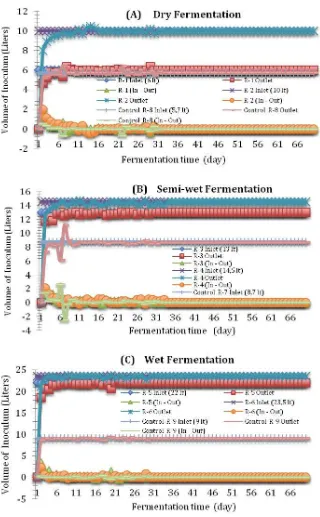PAPER • OPEN ACCESS
Biogas production from oil palm empty fruit
bunches of post mushroom cultivation media
To cite this article: Agus Purnomo et al 2018 IOP Conf. Ser.: Earth Environ. Sci.141 012024
View the article online for updates and enhancements.
Related content
Mechanical properties of unidirectional oil palm empty fruit bunch (OPEFB) fiber reinforced epoxy composite
C S Hassan, C W Yeo, B Sahari et al.
-Optimization of moistening solution concentration on xylanase activity in solid state fermentation from oil palm empty fruit bunches
Efri Mardawati, Parlan, Tita Rialita et al.
-Processing of oil palm empty fruit bunch as filler material of polymer recycles
D R Saepulloh, S Nikmatin and H Hardhienata
-Biogas production from oil palm empty fruit bunches of post
mushroom cultivation media
Agus Purnomo1), Suprihatin2), M Romli2), Udin Hasanudin3)
1)PhD student of Natural Resources and Environmental Management Studi Program, Bogor Agricultural University
1) Departement of Health Analyst, Health Polytechnic of Tanjungkarang 2)Department of Agro-Industrial Technology, Bogor Agricultural University,
Bogor-16680, Indonesia
3)Department of Agro-Industrial Technology, Faculty of Agriculture, University of Lampung,
Bandar Lampung-35145, Indonesia
Abstract.The Empty fruit bunches are one of the palm oil industry wastes, which can be used for mushroom cultivation. Post-cultivation of mushroom from former EFB-mushroom media (EFBMM) has the potential to be processed into biogas. The purpose of this research was to examine optimum co-digestion conditions for biogas production of EFBMM.The research was carried out in an anaerobic digester with three different conditions - dry fermentation (Water content (WC)/Total Solid (TS) ratio 1.5 - 3.5), semi-wet fermentation (WC/TS ratio = 4.0 - 5.7) and wet fermentation (WC/TS ratio> 9.0) conditions. Digester of capacity 50L was used. Fermentation was done using 20% cow feces as inoculum which then added with circulation system for 70 days. The results showed that optimum biogas production were produced in semi-wet fermentation conditions (WC/TS ratio = 4). It was produced 37.462 liters (2.420 liters CH4/Kg
Volatile Solid (VS)) of biogas with methane contain about 26.231%. Total volume of inoculum during process was 19.6 liters (1: 4 w/v) with absorbed TS inoculum ratio, TS/I = 0.4 (1:2.5 w/v). The result of research also showed that biogas which was produced from control about2.865 liters (0.041 liters CH4/KgVS) , with TS absorbed inoculum ratio, TS/I = 0.5 (1: 5w/v).
Keywords: Biogas,EFBMM, fermentation, WC/TS ratio, anaerobic digester
1. Introduction
Several efforts to manage the solid waste of palm oil (EFB) have been investigated by utilizing them as raw materials for bioethanol production [1], raw material for composting mixed with mud from Palm Oil Mill biogas production [2], raw material of Biomass power plant [3], and materials for Raw production of biogas [4-7].Biogas is one type of energy that can be generated from the anaerobic fermentation process of organic waste such as EFB, produced every day by the palm oil industry in a very abundant amount. Currently EFB waste is generally used as mulch and compost fertilizer for oil palm plantations. EFB utilization process is less profitable because the decomposition process runs very slow if its used as mulch or compost.
the organic compounds in the anaerobic atmosphere by anaerobic bacteria by adding activators such as palm oil mill effluent (POME) and livestock manure (dissolved cow manure).EFB dried at 95oC for 48 hours can be used as biogas feedstock using POME activator. The results showed that the mixture of EFB and POME (F/I) ratio (2:1) incubated at 37oC for 45 days resulted in the highest methane gas with production of 55 m3 CH4 / ton [4]. EFB treated with NaOH and drying first then mixed with POME (F/I) ratio (6.8: 1) can produce maximum methane gas as much as 82.7 m3 CH4/ton [8].
Sawdust and sawdust fungus media (Baglog) can also be used as raw material for making biogas with cow dung activator. It turned out that the volume of biogas produced from baglog raw material (C/N ratio = 57.79) was 28% higher than the volume of biogas from sawdust raw material (C/N ratio = 88.30). The fermentation process lasts for 32 days [9].In the dry anaerobic digester process, the parameters of; inoculum concentration, pH, moisture, temperature, total solids and C/N ratio are the main parameters affecting biogas production. In addition to the C/N ratio, the choice of raw materials used affects the volume of biogas produced [10].
Currently EFB has also begun to be utilized as a medium of planting mushroom with 2 monthly cycles. Post-utilization of EFB as baglog mushroom (EFBMM) has been used as a material of organic fertilizer (compost) but need to be left first for ± 2 months. Based on some of the previous reference, this research was done with utilization of raw materials as follows, 20% cow dung inoculum using dry anaerobic digestion.
The purpose of this study was to obtain an exact inoculum ratio, according to Brummeler and Koster (1989) the addition of an appropriate inoculum ratio would be advantageous during the start-up process [11]. In this study the exact inoculum determination was done by calculating the volume of inoculum that will be circulated in the fermentation process based on the total ratio of EFBMM + inoculum mixed water content (WC) with total solid (TS) of EFBMM + inoculum mixture (WC/TS ratio). To obtain the optimum condition, the fermentation was done with 3 variations on treatment, dry fermentation with the content of TS 22-40% and water content with 60-78% (WC/TS ratio 1.5 – 3.5), semi wet fermentation With TS content of 15-20% and water content 80-85% (ratio WC/TS = 4.0 - 5.7) and wet fermentation with TS <10% and moisture content> 90% (WC/TS ratio> 9.0). This research also conducts fermentation with the same condition for fresh EFB as control.
2. Materials and Methods
2.1. Materials Research
The materials used in this research are: Bunches of Blended Palm Oil former media of mushroom (EFBMM) as substrate obtained from strawmushroom farmers and cow dung which then added with water proportions of 1 kg: 5 liters as inoculum.
2.2 Research Utilities
Figure 1. A series of biogas making tools with circulation system
2.3 Implementation of Research
The parameters studied were to determine the optimum condition of biogas production (fermentation process). EFBMM with inoculum of cow dung on each digester with 3 treatments, i.e. wet fermentation (TS material <10%), semi-wet fermentation (TS material 15-20%) and dry fermentation (TS material 22-40%). The fermentation conditions on each digester can be determined by adjusting the volume of inoculum which is added/circulated by using the comparison equation between water content (WC) (Substrate + Inoculum) with total solid (TS ) content (Substrate + Inoculum ) using the following equation : q
From the above equation, the volume of inoculum that was circulated daily on each digester is presented in Table 1.
Table 1. Characteristic material and volume of inoculum that is circulated daily at each digester
Code WC
Description : WC = water content; TS = total solid, VI = volume of inoculum that is circulated daily
VS = Volatile Solid; Weight EFBMM each digester = 5 Kg
Water content of inoculum = 90.3% and TS inoculum = 9.7%
The experiment was carried out by inserting the 5 kg EFBMM into each digester with screened plaster on the bottom, then on the inside of the lid silicone glue was added and then closed tightly and ensured to be
A = a hose perforated lid inside the digester B = Screen bottom of the digester
Description:
1. Funnel U and circulation pipe equipped inoculum stop the tap
2. Place of sampling andbiogas volume measurement
airtight/no leakage. Each EFBMM-filled digester was added inoculum via a circulation pipe with volumes as presented in Table-1 and anaerobic fermentation process was then started. Process of fermentation takes place every day, during the process the measurement of biogas volume was calculated, also measured was the volume of inoculum which was channeled to the containment gallon. The volume-measured inoculum was then recycled into the same volume as the initial circulation volume. If there is a reduction/volume depreciation, then conduct the addition of inoculum onthe stock gallon and if there was an excess volume, the excess volume of inoculum was returned to the stock gallon. Measurement of biogas volume and circulation process was carried out continuously during the anaerobic fermentation process on the digester.
Biogas composition of each digester was measured once every week (7 days) . The biogas samples were taken directly on the biogas flow line of the digester using gas syringes and directly analyzed for the biogas composition (CH4 , CO2 and N2) using Gas Chromatography (Shimadzu GC 2014 ) with thermal conductivity detectors at 200 oC and 100 oC injection temperature. GC analysis used a Shincarbon column of 4.0 ms longs and 3 mm inner diameter with Helium gas as a gas carrier with a flow rate of 40 ml/min .
3. Results and Discussions
3.1. Material Characteristics In Digester
The raw materials used in the dry anaerobic digestion process are EFBMM which has been described, fresh EFB which had already pressed from the factory, then chopped as raw material for control and 20% cow feces as inoculum. The result showed that EFBMM used in research had average water content 41.10%, TS content 59.90%, C content 25.44%, N rate equal to 1.20%, and Ratio C/N amounted to 16.639. The presence of C and N content shows that EFBMM still has high organic and mineral element content, while low C/N ratio and high TS at EFBMM show that the raw material are susceptible to degradation, thus has the potential to be used as raw material for biogas production by dry Anaerobic digestions. Various parameters such as inoculum concentration, pH, moisture, temperature, total solids and C/N ratios are the main parameters affecting biogas production. In addition to the C/N ratio, the choice of raw materials used affects the volume of biogas produced [10]. The characteristics of EFBMM and inoculum in each digester are presented in Table 1. Raw materials (EFB-Fresh, EFBMM, and Cow dung) characteristics used in dry anaerobic digestions are presented in Table 2.
Table 2. Characteristics of raw materials
Parameters Unit Average levels
EFB-Fresh EFBMM Cow dung 20%
3.2. Biogas production resulted from fermentation process variations
Measurement of biogas volume of dry, semi-wet and wet fermentation process were done by using gas flow meter. The biogas production accumulation curve in each digester treatment was presented in Figure 2. Figure 2 shows that the highest biogas production was produced by R-3 with a total volume of 37.47 liters (7.49 liters/kg EFBMM) with solid residence time (SRT) 70 days with WC/TS ratio of raw materials of EFBMM 4.0 . In the same condition the ratio of WC/TS and SRT produced in the control digester (R-7) using fresh raw material EFB is 2.86 liters (0.57 liters/kg EFB). While the result of measurement and calculation of cumulative volumes of biogas compared with the amount of volatile solid (VS) in each digester of the study is presented in drawing 3. Figure 2 shows that the accumulative volume of biogas in dry fermentation group , control digester (R-8) produces biogas Higher than the R-1 and R-2 digesters, but in Fig. 3 it was found that the volume of methane gas (CH4) produced was still the lowest in the treatment group, ie R-8 0.408 liters/KgVS , R-1 0.571 liters/KgVS and R-2 1.189 liters/KgVS . Physically EFB fiber has a strong fiber, so it takes a long time to be decomposed. The presence of biogas produced in the dry anaerobic digesters process was derived from organic materials such as oil residues from the pressing process of the plant and fibers attached to the EFB [12] .
Figure 2 showed thatthe average of all the digester treatments showed an increase in biogas production after 4 weeks, the same as reported by Lu et al. that during the dry anaerobic process, the pH decreased from the initial conditions of 6.7 to 4.2 under mesophilic conditions and pH 5.8 under thermophilic conditions for the first 2 weeks. Furthermore the pH gradually increased to 7.6 after 4 weeks with a digester temperature of 35oC and pH 8 after 3 weeks with digester temperature of 55oC [11].
Figure 3. Cumulative volume of gases CH4based on levels VS
3.3. Optimization of fermentation process
In the determination of fermentation optimization EFBMM uses 20% cow dung inoculum which is circulated with variation on treatment of R-1 (WC/TS 2,3), R-2 (WC/TS 3.0), R-3 (WC/TS 4.0), R-4 (WC/TS 5.7), R-5 (WC/TS 9.0) and R-6 (WC/TS 11.5) results of said biogas produced were 1.42 L/Kg; 2.12 L/kg; 7.49 L/kg; 1.31 L/kg; 0.98 L/kg and 0.34 L/kg EFBMM. From the data, the optimum condition of the fermentation process can be clearly seen in the curve of Figure 4. From Figure 4, it shows that EFBMM fermentation using 20% cows dung inoculum with circulation system in semi-wet condition (ratio of WC/TS = 4) can produce more biogas compared to the conditions of dry fermentation and wet fermentation. The drier or wetter the fermentation condition, can decrease biogas production. If calculated on the basis of the VS content of each EFBMM raw material, the CH4 gas volume produced under the optimum condition of the semi-wet fermentation process (R-3) was 2.42 L KgVS.When compared with the results reported by Hasanudin et al. 2015, the cumulative volume of biogas generated in this research turned out to be only 10 percent of biogas production from anaerobic composting process of fresh EFB and POME which expected [12].
3.4. The composition of biogas produced on the variety of the fermentation process
In the process of determining the optimum conditions of fermentation in this study, no observations were made on other factors such as temperature and pH digester. In the determination of optimum conditions the researchers only wanted to know the best WC/TS ratio of theusage of inoculum circulation process. Based on the data presented in Table 3, the CH4 gases content generated from each digester ranged from 3.218% to 24.63%. CH4 gas content of this research was lower when compared with previous studies. Biogas formed from into co-composting process of EFB and POME can produce biogas with CH4 gas content of 40.1% [12]. Other research results reported by Amelia JR et al. (2017) stated that CH4 gases content in the anaerobic process of composting fresh fruit bunch (FFB) with 20 litres of POME per day, can produce 51.08% CH4. The CH4 gas content exceeding 45% will be highly flammable and can be a proper fuel because the high calorific fuel value [13]
Table 3. Gas composition CH4each digester
Parameter
Figure5. CH4 gas trend curveon fermentation process variation
3.5. The volume of inoculum that was circulated on the variety of fermentation processes
In the anaerobic fermentation process, the solid organic matter in the digester requires the inoculum to speed up the reaction process. Inoculation can improve digestion efficiency of the digester and may reduce the residence time of solids [11].
Table 4. Volume of inoculum in each digester
Description R-1 R-2 Control
R-8 R-3 R-4
Control
R-7 R-5 R-6
Control R-9
Vol. of circulation-Inoculum (L/day) 6 10 5.7 13 14.5 8.7 22 23.5 9
Weight TS EFBMM (Kg) 3.64 3.465 3.365 2.715 2.48 2.1 2.585 3.1 1.345
Absorbed Inoculum Vol (L) 3.55 5.35 0.15 6.6 10.15 4.05 10.5 6.35 0.35
The Ratio TS/I adsorbed 1.0 0.6 22.4 0.4 0.2 0.5 0.2 0.5 3.8
Figure6. The inoculums circulation volume curva in dry (A), semi-wet (B) and wet (C) fermentation
4. Conclusions
The optimum condition of biogas production using EFBMM raw material takes place in semi-wet fermentation with
WC/TS ratio was 4, with biogas volume produced 37.462 liters (2.420 liters CH4/KgVS). While control samples
biogas yields was 2.865 liters (0.041 liters CH4/KgVS). Under optimum condition, the average concentration of CH4
gas produced were 16.356% with the lowest CH4 concentration being 7.872% at startup and the highest
concentration was 26.231% at maximum production. The total volume of inoculum used at optimum conditions during the circulation process were 19.6 liters with a TS/I ratio of 0.4 or (1:2.5 w/v).) and the total volume of inoculum in the control were 12.75 Liters with a ratio of TS/I = 0.5 or (1:5 w/v)
Acknowledgements
The authors would like to thank the Center for Human Resources Development (PPSDM) Health Ministry of Health of the Republic of Indonesia which has provided financial support (Cost of Education), thank you also to the Study Program of Natural Resources Management and Environment IPB, Faculty of Agriculture of UNILA, and Analytical Laboratories of Department Agro-Industrial Technology UNILA, for the provision of data, information and discussion.
References
[1] Sudiyani Y, Styarini D, Triwahyuni E, Sudiyarmanto, Sembiring KC, Aristiawan Y, Abimanyu H, Han MH 2013 Utilization of biomass waste empty fruit bunch fiber of palm oil for bioethanol production using pilot-scale unit. Journal Energy Procedia 3231-38.
[2] Nutongkaew T, Duangsuwan W, Prasertsan S, Prasertsan P 2014 Effect of inoculum size on production of compost and enzymesfrom palm oil mill biogas sludge mixed with shredded palm empty fruit
bunches and decanter cakeJournal of Science and Technology36 275-281.
[3] Wijono A 2014PLTU biomasa tandan kosong kelapa sawit studi kelayakan dan dampak lingkungan.
Simposium nasional RAPI XIII-2014 FT UMS, ISSN 1412-9612.
[4] Chaikitkaew S, Kongjan P, O-Thong S 2015Biogas production from biomass residues of palm oil mill 3by solid state anaerobic digestion. Journal Energy Procedia 79838 – 844.
[5] Nieves DC, Karimi K, Horváth IS. 2011. Improvement of biogas production from oil palm empty fruit
bunches (OPEFB). Journal Industrial Crops and Products 34 1097–1101.
[6] Nurliyana MY, H’ng PS, Rasmina H, Kalsom MSU, Chin KL, Lee SH, Lum WC, Khoo GD
2015Effect of C/N ratio in methane productivity and biodegradability during facultative
co-digestion of palm oil mill effluent and empty fruit bunch Industrial Crops and Products 76 409-415.
[7] Suksong W, Kongjan P, Prasertsan P, Imai T, O-Thong S 2016 Optimization and microbial community analysis for production of biogas from solid waste residues of palm oil mill industry by solid-state
anaerobic digestionJournal Bioresource Technology 214166-174.
[8] O-Thong S, Boe K, Angelidak I 2012Thermophilic anaerobic co-digestion of oil palm empty fruit
bunches with palm oil mill effluent for efficient biogas productionJournal Applied Energy 93
648-654.
[9] Mulyadi D, Mukmilah L, Kusumawati D 2016 Efektifitas pemanfaatan serbuk gergaji dan limbah
media tanam jamur (baglog) sebagai bahan baku pembuatan biogas Jurnal Kimia Valensi 2 11-16.
[10] Dioha IJ, Ikema CH, Nafi’u T, Soba NI, Yusuf MBS 2013 Effect of carbon to nitrogenratio on
biogas production International Research Journal of Natural Sciences 1 1-10.
[11] Jha AK, Li J, Nies L, Zhang L 2011 Research advances in dry anaerobic digestion process of solid
organik wastes African Journal of Biotechnology 10 14242-14253
[12] Hasanudin U, Sugiharto R, Hariyanto A, Setiadi T, Fujie K 2015 Palm oil mill effluent treatment and utilization to ensure the sustainability of palm oil industries Journal Water Science & Technology. [13] Amelia JR, Suprihatin S, Indrasti NS, Hasanudin U, Fujie K 2017 Performance evaluation of
integrated solid-liquid wastes treatment technology in palm oil industryIOP Conf.Serise: Earth and
[14] Pilat P, Patsch M, Jandacka J 2012Analysis of problems with dry fermentation process for biogas
production EPJ Web Conferences 25 01075
[15] Kunatsa T, Madiye L, Chikuku T, Shonhiwa C, Musademba D 2013 Feasibility study of biogas
production from water hyacinth A case of lake Chivero – Harare, ZimbabweInternational Journal of






